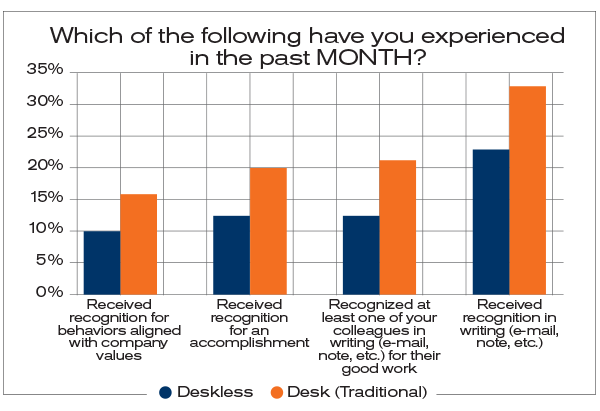When I think back to my job at one of the busiest malls in the United States, I often remember how exhausted I was. Although I was working no more than 20 hours a week, I felt as if I had been consistently clocking overtime.
In my current position—double the hours—I feel energized and excited to come in and tackle the day’s challenges.
The key difference between these roles: I am currently working a desk job, while my previous role was deskless.
Deskless jobs
You might not know what they are, but you most likely have worked one. These are roles where employees don’t spend the majority of their day behind a desk or at a laptop—retail, warehouse and restaurant roles, for example. Because these employees are more than just a click away, they are often excluded from company communications and programs and, therefore, are often overlooked and underappreciated.
The term “deskless” is somewhat new, but the conversation surrounding the treatment of these employees has been around for years. Previously, the term used by many was “disconnected,” but results from our global New Rules of Engagement® study show 80% of these employees reported having some sort of electronic device that allowed their employer to communicate with them.
Feeling in the loop and recognized for my contributions in my job makes me feel like I belong here. In all, I completed the same amount of training in my job at the mall as I have in my current position, but a lack of follow-up communication meant there were no next steps taken to encourage the behaviours I’d learned, nor was there ongoing recognition when I successfully put that training into action.
And that story is not just anecdotal. Despite the ubiquity of electronic communication devices in a deskless workplace, only 36% of deskless employees report receiving training and only 34% report receiving recognition on their device.
When we asked those employees about recognition actions they experienced in the past month, compared to their traditional office-housed counterparts, the results were stark:

The study shows employees who receive meaningful recognition are 10x more likely to be inspired than those who don’t and inspired employees are twice as likely to stay at their employer for the next 12 months, but deskless employees receive recognition half as often as office workers.
So what now? We know the majority of deskless workers have a handheld communication device at work. Mark Hirschfeld, BI WORLDWIDE’s Vice President of consulting and Strategy Partnerships, shares six ways you can use that avenue to bridge the communication gap, drive engagement and foster belonging in your organization.
1. Align to key business challenges
Employers of deskless employees face industrial safety, retention, customer service and absenteeism challenges. Recognize and reward employees for positive outcomes in key areas. For strategic communication, tools like BIW’s Impact Advisor can help you build your case and get the program off the ground.
2. Integrate with the electronic tools you already use
A large and growing number of employers already have a way to communicate electronically with employees. Many handheld devices, like those from Zebra Technologies, already have the ability to integrate with recognition and reward ecosystems, facilitating a “one-stop-shop” approach.
3. Have an adoption strategy
Just because there’s an app available to participants doesn’t mean there will be adoption unless you implement a comprehensive strategy to solve for it. Best practices include on-location advocates and gamification elements to improve participation. Ongoing manager training and recognition can have a significant impact on local implementation.
4. Tell the story, expansively
Communicating the key elements of an initiative—safety, customer service, etc.—is critical to driving engagement. Using electronic communications is important, but using offline tools like branded merchandise, displays and breakroom leaderboards is important to sustain the story.
5. Share early successes
As employees respond to the program and results improve, showcase early successes. This could be highlighting one associate who, for example, helped a difficult customer and maintained their business or recognizing a string of days at a manufacturing plant that had no errors. These early wins can inspire employees and reinforce ideas of how they can be successful.
6. Continue to measure success and make adjustments as needed
Most programs will require periodic review and identification of next steps. For example, early in a program, skills training may be offered to get employees off to a great start. After greater adoption of those skills, more advanced training can be offered.
Deskless no longer means disconnected. Use the same tactics and resources that inspire your office employees to elevate your organization’s employee experience wherever work happens.




